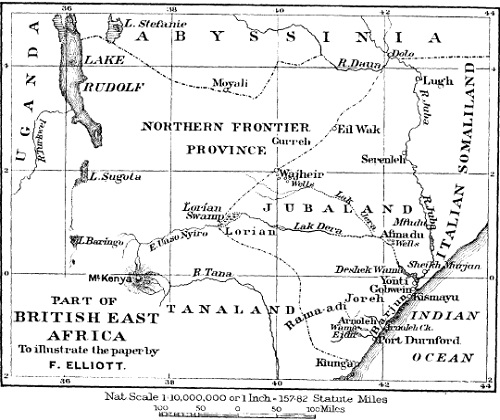At Arnoleh [Anooleh] is the only settlement of the Gala tribe in Jubaland, though they are to be found scattered among the Somali throughout the whole country. Monseigneur Taruin Cahaigne, of Harrur in Abyssinia, has suggested, according to Colonel Swayne, that this tribe had their original local habitation in Tanaland. It would appear more probable, from inquiries made from the Gala themselves, that their tribe came from the north of Italian Somaliland, whence they were driven by the more powerful Somali; and that they first took refuge in Jubaland and afterwards in Tanaland, where a large settlement of them still exists.

Northern Somaliland can show many cairns of Gala origin, but in Jubaland I have found not one. It appears that, after being driven across the Juba by the Somali, the Gala took possession of the country to the west of that river. About 1842 the Somali crossed the Juba, attacked the Gala, and were defeated with great loss. These attacks were continued until 1845, when tbe Somali offered peace on condition that they should be allowed to inhabit Jubaland side by side with the Gala. The Gala foolishly consented to this. In 1848 the Somali treacherously broke the agreement, and drove the Gala south ward and westward. Many of them were starved into servitude under the Somali, and are now employed in considerable numbers as
herdsmen in the Ogaden country. The Gala are mostly Pagans, but lately a considerable number of them have become converts to Mohammedanism. Their marriage customs do not include the giving of a dowry, and their conjugal morality is very lax. In intelligence they compare unfavourably with the Somali; nevertheless they are a courageous and usually self-restraining race, yet subject to violent fits of excitement when sufficiently provoked. As traders and hunters they are more skilful than a Somali, but not equal to the Boni.
The Kismayu district may be said to extend from the coast northward to the Deshek Wama lake, and on the east it is bounded by the Juba river. Kismayu, which may be considered as the capital of Jubaland, possesses a well-protected roadstead. It contains about 4000 inhabitants – consisting of Somali , a few Indian traders, and Bajun. It exports hides, maize, and cotton; it imports manufactured articles, especially cotton cloth of all descriptions. The trade at present is mostly in the hands of Khojas from Bombay. The goods are principally made in Hindustan or America. Very few British-made articles reach the country. As the seat of the Government, it is the residence of a few English officials.
, a few Indian traders, and Bajun. It exports hides, maize, and cotton; it imports manufactured articles, especially cotton cloth of all descriptions. The trade at present is mostly in the hands of Khojas from Bombay. The goods are principally made in Hindustan or America. Very few British-made articles reach the country. As the seat of the Government, it is the residence of a few English officials.
Gobwein (“large plain“), 2 miles from the Juba mouth, is a village of about 2000 inhabitants. Yonti, 12 miles from Gobwein, is also situated on the Juba river. It is a military cantonment. Near this village an English company has commenced the cultivation of cotton.